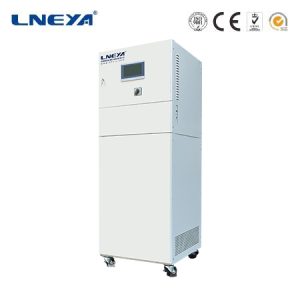Für welchen Prozess in der Halbleiterfertigung wird ein Mehrkanal-Kühler benötigt? Warum ist er notwendig?
In the semiconductor manufacturing process, multi-channel chillers are mainly used in key process links that require high-precision temperature control and large-scale heat management.
Here are some typical usage scenarios and reasons:
Chemical Vapor Deposition (CVD): In the CVD process, a multi-channel chiller is used to cool the reaction chamber walls, heat exchangers, and gas preheating exchangers to maintain stable reaction chamber temperature, ensuring precise control of film thickness, uniformity, and chemical reactions.
Etching and etching: Both dry etching and wet etching require precise temperature control. The multi-channel chiller ensures the temperature of the etching equipment and chemical bath, which affects the etching rate, selection ratio, and graphic accuracy.
Ion implantation: The ion source and target chamber need to be cooled by a chiller to control temperature, prevent overheating from affecting ion energy dispersion, and ensure the accuracy of injection depth and dosage.
Heat treatment: such as oxidation, diffusion, annealing, nitriding, multi-channel chiller controls furnace temperature to ensure uniform temperature, affecting diffusion rate, activation, and impurity distribution.
Testing equipment: such as probe testing and aging testing benches, multi-channel chillers control the testing environment temperature to ensure equipment stability and reproducibility of test results, especially for high or low temperature testing.
Why do need a multi-channel chiller?
Temperature control accuracy: Multi channel design can more accurately control the temperature of each area, reduce temperature fluctuations, and ensure process consistency.
High heat load management: Semiconductor manufacturing generates a large amount of heat energy, and multi-channel can effectively handle a large amount of heat load to ensure equipment operation safety and efficiency.
Flexibility: Multiple channels can be independently adjusted to meet specific temperature requirements of different processes or equipment sections, increasing process flexibility.
Reliability: Redundant hot backup, single channel failure does not affect overall operation, improves system stability, and reduces downtime.
In summary, the application of multi-channel chillers in semiconductor manufacturing is based on high requirements for temperature control accuracy, thermal energy management, production efficiency, and process stability, ensuring the performance and yield of semiconductor devices.
Verwandte Empfehlungen
-
Temperaturregelung und Kältemaschinen im Oxidationsdiffusionsverfahren
1245The oxidation diffusion process is a key step in semiconductor manufacturing. It is mainly used to form precise oxide layers and doping, and has extremely strict requirements for temperature control. In this process, the chiller, as an imp...
Details anzeigen -
FLT -45℃~40℃
2371Modell FLT-402 FLT-402W FLT-403 FLT-403W FLT-404 FLT-404W FLT-406 FLT-406W FLT-408 FLT-408W FLT-410 FLT-410W FLT-415 FLT-415W Temperaturregelung -45℃~40℃ Genauigkeit der Temperaturregelung ±0,1℃ Durchflussregelung 10~25L/min 5bar max 15~45L/m...
Details anzeigen -
Why do semiconductor manufacturing companies need heating circulator equipment?
1631Temperature Control Accuracy: The semiconductor manufacturing process has extremely strict requirements for temperature control. The heating circulator can provide precise temperature control, ensuring that the temperature remains withi...
Details anzeigen -
ZLJ-Reihe
3218Mehrere Regelungsanforderungen können durch die Zusammenlegung mehrerer Geräte in einem größeren Schrank erfüllt werden Verwendet für kleine Wärmeaustauschfläche und große Wärmeaustauschkapazität Das Produkt gibt direkt...
Details anzeigen
 LNEYA Industriekühler Hersteller Lieferant
LNEYA Industriekühler Hersteller Lieferant












